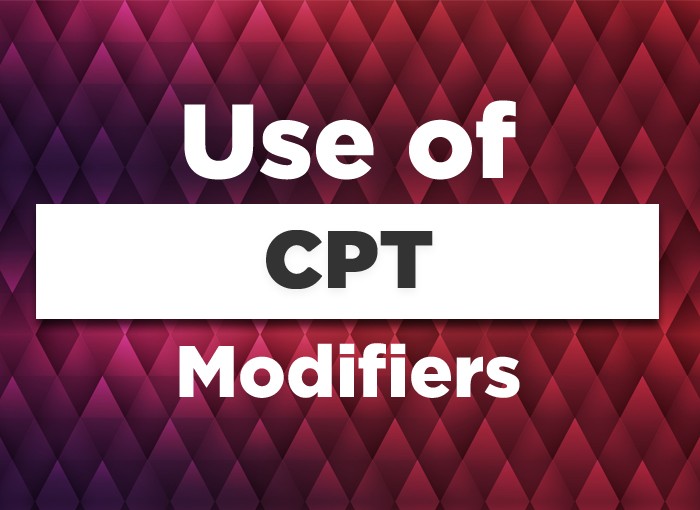Correct use of CPT Modifiers to Maximize Reimbursement
According to the Current Procedural Terminology (CPT) book, a modifier is a “means to report or indicate that a service or procedure that has been performed has been altered by some specific circumstance but not changed in its definition or code.”
List of CPT Modifiers with Description
- 22: Increased Procedural Services (not for E/M services)
- 24: Unrelated Evaluation and Management Service by the Same Physician or Other Qualified Health Care Professional During a Postoperative Period
- 25: Significant, Separately Identifiable Evaluation and Management Service by the Same Physician or Other Qualified Health Care Professional on the Same Day of the Procedure or Other Service
- 33: Preventive Services
- 50: Bilateral Procedure
- 51: Multiple Procedures
- 53: Discontinued Procedure
- 54: Surgical Care Only
- 57: Decision for Surgery
- 58: Staged or Related Procedure or Service by the Same Physician or Other Qualified Health Care Professional During the Postoperative Period
- 59: Distinct Procedural Service
- 62: Two surgeons
- 66: Surgical Team
- 78: Unplanned Return to the Operating/Procedure Room by the Same Physician or Other Qualified Health Care Professional Following Initial Procedure for a Related Procedure During the Postoperative Period
- 79: Unrelated Procedure by the Same Physician or Other Qualified Health Care Professional During the Postoperative Period
- 81: Minimum Assistant Surgeon
- 82: Assistant Surgeon (when qualified resident surgeon not available)
List of HCPCS Modifiers with Description
- AA: Anesthesia services personally performed by the anesthesiologist
- AD: Supervision, more than four procedures
- AH: Clinical psychologist
- AJ: Clinical Social Worker (CSW) rendered a diagnostic or therapeutic service
- AS: Physician assistant, nurse practitioner, or clinical nurse specialist services for assistant at surgery
- E1: Upper left, eyelid
- GA: Waiver of Liability Statement Issued, as Required by Payer Policy
- GC: Service performed in part by a resident under the direction of a teaching physician
- GE: Service performed by a resident without the presence of a teaching physician under the primary care exception (except ambulance services)
- GX: Notice of liability issued, voluntary under payer policy
- GY: Item or service statutorily excluded, does not meet the definition of any Medicare benefit
- GZ: Item or service expected to be denied as not reasonable and necessary
- P1: A normal healthy patient
- P2: A patient with mild systemic disease
- P3: A patient with severe systemic disease
- P4: A Patient with severe systemic disease that is a constant threat to life
- P5: A moribund patient who is not expected to survive without the operation
- P6: A declared brain-dead patient whose organs are being removed for donor purposes
- PT: Colorectal cancer screening test; converted to diagnostic test or other procedure
- Q6: Service furnished by a locum tenens physician
- Q7: One Class A Finding
- Q8: Two Class B Findings
- Q9: One Class B and Two Class C Findings
- QK: Medical direction of two, three, or four concurrent anesthesia procedures
- QW: Clinical Laboratory Improvement Amendment (CLIA) waived test
- QX: Qualified non-physician anesthetist with medical direction by a physician
- QY: Medical direction of one CRNA/AA by an anesthesiologist
- QZ: Certified Registered Nurse Anesthetist (CRNA) without medical direction by a physician
- RT: Right side
- TC: Technical Component
Using incorrect modifiers can result in denial of medical claims. Health care providers must use modifiers correctly to support the medical services offered to their patients.




